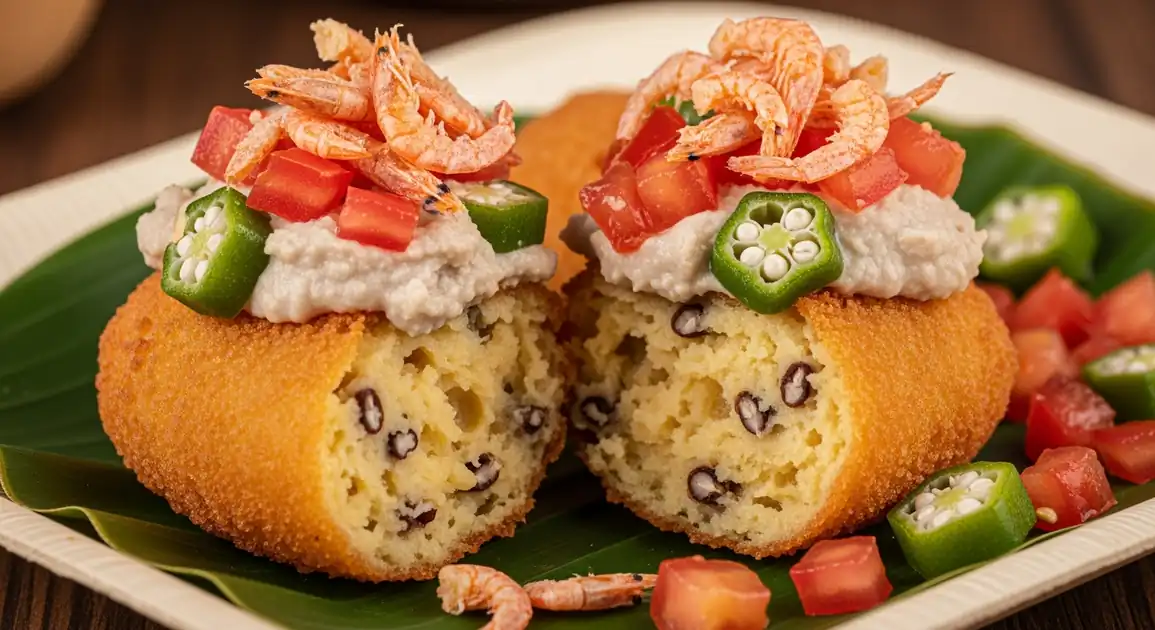Acarajé
Acarajé

Description
Acarajé is available throughout Brazil but is most authentic in the Northeast, particularly Bahia, where it originated in Brazilian culture. While now found nationwide due to internal migration, the traditional preparation by Baianas de Acarajé (women vendors in traditional dress) is most common in the Northeast. In other regions, it's often found at Northeastern-themed restaurants or specialty street food markets.
Dietary Information
Serving information
Serving style
Traditionally served wrapped in paper or banana leaf. Eaten by hand, typically standing near the vendor. Often accompanied by cold beverages like sugarcane juice or coconut water.
Quick facts
Most vendors operate from late afternoon until late evening (4 PM - 11 PM), with weekend hours often extended.
Safety Tips
What to Look For
-
Fresh, reddish-orange dendê oil
Quality dendê oil should have a vibrant color and pleasant aroma. Dark or murky oil indicates overuse and can affect both taste and safety.
-
Baianas frying acarajé to order
Freshly fried acarajé ensures proper cooking temperature and minimizes time in the temperature danger zone.
-
Properly stored toppings and fillings
Vatapá, caruru, and other toppings should be kept in clean, covered containers and appear fresh. Refrigeration or ice beneath containers is ideal, especially for vatapá which contains seafood.
-
Clean workstation and utensils
Look for vendors who maintain clean preparation areas, regularly wipe surfaces, and keep separate utensils for different toppings.
-
Hand hygiene practices
Vendors should wash hands between handling money and food or use assistants/family members to handle transactions.
-
High customer turnover
Popular stands with regular customers typically maintain better quality and freshness standards.
What to avoid
-
Pre-fried acarajé sitting out for extended periods
Acarajé should be fried fresh or very recently. Avoid vendors with large batches sitting out, especially in hot weather.
-
Dark, smoking, or foul-smelling oil
Overused dendê oil loses its characteristic color and develops unhealthy compounds. The oil should not be smoking or smell burnt/rancid.
-
Uncovered or unrefrigerated vatapá and seafood toppings
These contain ingredients that can spoil quickly in warm weather. They should be kept covered and cool.
-
Vendors handling money and food without washing hands
This practice can transfer bacteria and contaminants to your food.
-
Dirty preparation area or flies around the food
These indicate poor hygiene standards that could affect food safety.
Price information
Price range
Budget tips
- Prices vary significantly between tourist areas and local neighborhoods - expect to pay 8-15 BRL in local areas and 15-25 BRL in tourist zones.
- Larger acarajé with more fillings naturally cost more - some vendors offer half-size options for budget travelers.
- Festival or event prices are typically higher than street stands.
- Consider sharing one acarajé when first trying it, as they are usually quite substantial.
Value indicators
- Freshly fried in your presence.
- Generous filling without skimping on traditional components.
- Clean, well-maintained stand with visible ingredients.
- Proper traditional attire of the Baiana (white dress, turban).
- Vibrant reddish dendê oil, not dark or overused.
Where to Find This Dish
Cultural Centers
Near museums, historic sites, and tourist areas, especially those highlighting Afro-Brazilian culture.
Public squares, Historic districts, Cultural centers
Afternoon, Evening
Beach Areas
Popular along promenades and beach access points in coastal cities.
Beachfront kiosks, Promenades
Late Afternoon, Evening
Markets
Weekly or permanent markets, especially those featuring regional foods.
Feiras (street markets), Food halls
Market operating hours
Vendor Tips
- Traditional Baianas (women in white dresses with turbans) typically make the most authentic acarajé.
- Watch for official certification - in some cities, authentic Baianas have credentials from cultural heritage organizations.
- Vendors with photos displaying their connection to Bahia or Candomblé traditions often take pride in authenticity.
How to Order
Regional Variations
-
Traditional Acarajé
(Acarajé Tradicional)
The classic version with all traditional fillings: vatapá, caruru, dried shrimp, and diced tomatoes and onions.
-
Acarajé without Shrimp
(Acarajé sem Camarão)
Modified version for those with shellfish allergies or vegetarians, omitting the dried shrimp topping and using shrimp-free vatapá.
-
Mini Acarajé
(Acarajézinho)
Smaller version popular as an appetizer or at events, typically with the same fillings but in bite-size portions.
-
Stuffed Acarajé
(Acarajé Recheado)
Modern variation with additional fillings like cheese, chicken, or more elaborate seafood combinations beyond the traditional components.
-
Special Acarajé
(Acarajé Especial)
Premium version with extra toppings or higher quality ingredients, often found at more upscale vendors or restaurants.
-
Abará
(Abará)
Related dish using the same black-eyed pea base but steamed in banana leaves rather than fried, resulting in a softer texture.
Cultural context
History
Acarajé arrived in Brazil through enslaved West Africans, particularly from the Yoruba people, in the 16th century. Originally called 'akara' in Yoruba language, it was transformed in Brazil with local ingredients while maintaining its cultural significance. In Candomblé, an Afro-Brazilian religion, acarajé serves as a sacred offering to the orixá (deity) Iansã. The Baianas de Acarajé, traditionally dressed women who prepare and sell this food, were recognized as cultural heritage by IPHAN (Brazil's historical and artistic heritage institute) in 2005, acknowledging their crucial role in preserving this culinary tradition.
Local significance
Acarajé is more than food in Brazil; it's a cultural symbol representing Afro-Brazilian heritage and religious traditions. The Baianas de Acarajé are recognized as living cultural treasures preserving ancestral knowledge.
Eating customs
- Eaten standing near the vendor as street food.
- Acceptable to request more or less of specific toppings.
- Often accompanied by a cold drink to balance the rich flavors.
- Using provided napkins is essential as it's intentionally messy.